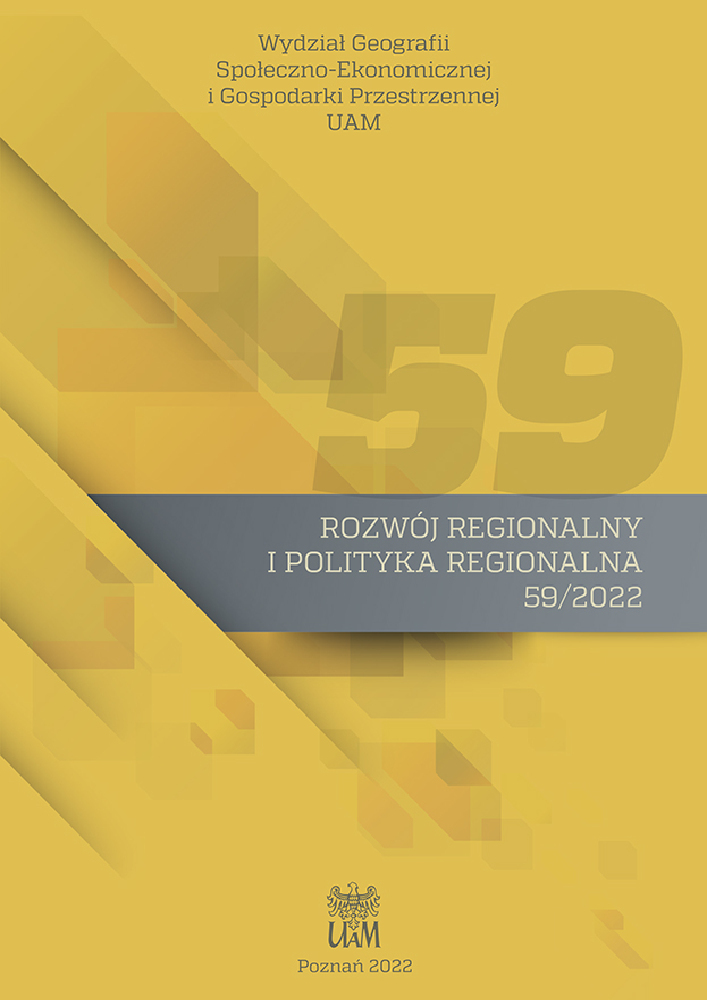Abstract
The compact way of shaping urbanized centers is a natural, historically established direction of development of settlement units. Compact cities are characterized by: controlled, in opposition to the spontaneous spread of buildings, development of the urban tissue, setting the boundary of the spatial expansion of the center and a relatively high rate of investment intensity. Significant distinguishing features of the concentric shaping of urban structures are the observed tendency to maintain the spatial continuity of the development of urban tissue and to use the internal potential of the centers (brownfields, revitalization of the used resource). The direction of compact shaping of urbanized areas, thanks to the economical and effective management of resources and by enhancing the potential of cities, guarantees the multidimensional development of urban centers. Considering the changes in the settlement network in the conditions of widespread urban sprawl and the loss of some functions by central centers, the question becomes what kind of development model should be adopted and what tools should be chosen in the conditions of global functional, spatial and demographic changes in contemporary cities?
Research shows that the inclusion of the housing sphere in an integrated development policy is a real opportunity to counteract the negative trends in urbanization. Studies on the Viennese housing issue
– advanced in action and effective in the results of implementation – allow the identification of good practices within the urban policy that favor the concentric shaping of urban structures. The analysis of the above example gives grounds for the claim that housing is strongly correlated with urban planning. The review of the Viennese housing issue allows for articulating the relationship between the features of the housing policy and the direction of urban growth in the metropolis. The analysis of Vienna’s experience was used in an attempt to capture the prospects for the development of housing policy, including the formulation of recommendations for an integrated policy of compact cities and setting its main principles. The considerations were supplemented with the author’s discussion of the housing policy of a compact city. It is an open concept for the development of the center, adapted to the changes in contemporary agglomerations in terms of spatial and functional aspects and responding to social changes.
References
Breiling M., Ruland G. 2008. The Vienna Green Belt: From Localised Protection to a Regional Concept. [W]: M. Amati (red.), Urban Green Belts in the Twenty-first Century. Ashgate, Londyn, s. 167, 172. Academia academia.edu (https://doi.org/10.4324/9781315548838).
Bradecki T. 2020. Planowanie miasta zwartego na przykładach konkursowych projektów urbanistycznych: przypadek dzielnicy Stargardu Szczecińskiego Giżynek. Studia Miejskie, 19: 47-57 (https://czasopisma.uni.opole.pl/index.php/sm/article/view/2503; dostęp: 10.03.2021). DOI: https://doi.org/10.25167/sm.2365
Dantzig G., Saaty T. 1973. Compact city: a plan for a liveable urban environment. W.H. Freeman and Company, San Francisco.
Department of Economic and Social Affairs 2014. Population Division, World Urbanization Prospects The 2014 Revision. Report, New York (https://population.un.org/wup/Publications/Files/WUP2014-Report.pdf; dostęp: 11.03.2021).
Economist Intelligence Unit 2021. Intelligence Unit (https://www.eiu.com/topic/liveability; dostęp: 29.03.2021).
Giecewicz J. 2008. Konserwatywna awangarda. Wiedeńska polityka mieszkaniowa 1920-2005. Oficyna Wydawnicza Politechniki Warszawskiej, Warszawa.
Giecewicz J. 2020. Miejska polityka mieszkaniowa – tereny dostępne warunkiem realizacji programów mieszkań dostępnych – nowelizacja ustawowa w Wiedniu. Środowisko Mieszkaniowe, 30: 47-52 (https://doi.org/10.4467/25438700SM.20.005.12208). DOI: https://doi.org/10.4467/25438700SM.20.005.12208
Komisja Europejska 2011. Miasta przyszłości. Wyzwania, wizje, perspektywy. Raport, Luksemburg (https://doi.org/10.2776/53888).
Komisja Europejska 2030. Agenda Terytorialna 2030. Przyszłość dla wszystkich obszarów, Niemcy (https://territorialagenda.eu/wp-content/uploads/TA2030_jul2021_pl.pdf; dostęp: 24.04.2022).
Komisja Europejska 2030. Nowa Karta Lipska. Transformacyjna siła miast na rzecz wspólnego dobra, Niemcy (https://www.gov.pl/web/fundusze-regiony/nowa-karta-lipska-i-agenda-terytorialna-ue-2030-przyjete-przez-ministrow-krajow-wspolnoty-europejskiej; dostęp: 24.04.2022).
Kozaczko M. 2017. Efektywność komunikacyjna miasta zwartego. Rozwój Regionalny i Polityka Regionalna, 37: 27-40 (https://doi.org/10.14746/rrpr.2017.37.03).
Lang R., Stoeger H. 2017. The role of the local institutional context in understanding collaborative housing models: Empirical evidence from Austria. The International Journal of Housing Policy, 18: 35-54 (https://doi.org/10.1080/19491247.2016.1265265). DOI: https://doi.org/10.1080/19491247.2016.1265265
Majda T., Mironowicz I. (red.) 2017. Manifesty urbanistyczne. W poszukiwaniu współczesnego modelu miasta. Towarzystwo Urbanistów Polskich, Biblioteka Urbanisty, Warszawa
Majda T., Mironowicz I. 2017. Manifesty urbanistyczne. W poszukiwaniu współczesnego modelu miasta. [W]: T. Majda, I. Mironowicz (red.), Manifesty urbanistyczne. W poszukiwaniu współczesnego modelu miasta. Towarzystwo Urbanistów Polskich, Biblioteka Urbanisty, Warszawa, s. 6-8.
Matsumoto T. 2011. Compact City Policies: Comparative Assessment, Compact City Policies: Comparative Assessment. Report, China, Wuhan 47th ISOCARP Congress 2011, 24-28 October 2011 (http://www.isocarp.net/Data/case_studies/2028.pdf; dostęp: 12.03.2021).
Medeksza Ł. 2017. Gra w karty urbanistyczne. [W]: T. Majda, I. Mironowicz (red.), Manifesty urbanistyczne. W poszukiwaniu współczesnego modelu miasta. Towarzystwo Urbanistów Polskich, Biblioteka Urbanisty, Warszawa, s. 174-180
Mercer 2021. Quality of living ranking (https://mobilityexchange.mercer.com/Insights/quality-of-living-rankings; dostęp: 29.03.2021).
Mierzejewska L. 2015. Miasto zwarte, rozproszone, zrównoważone. Studia Miejskie, 19: 9-22 (http://www.studiamiejskie.uni.opole.pl/wp-content/uploads/2016/05/S_Miejskie_19_2015-Mierzejewska.pdf; dostęp: 12.03.2021).
Ogrodnik K. 2015. Idea miasta zwartego – definicja, główne założenia, aktualne praktyki. Architecture et Artibus, 7(4): 35-42 (http://yadda.icm.edu.pl/baztech/element/bwmeta1.element.baztech-a93ddef1-571e-4dcc-ac91-5a8803ba9666; dostęp: 30.03.2021).
Österreich 2020. Wien: Lebenswerteste Stadt der Welt! (https://www.austria.info/de/reiseziele/staedte/wien#top-highlights-in-wien; dostęp: 29.03.2021).
Paszkowski Z. 2011. Miasto idealne w perspektywie europejskiej i jego związki z urbanistyką współczesną. Towarzystwo Autorów i Wydawców Prac Naukowych Universitas, Kraków, s. 43-44.
Referat für Wohnbauforschung und internationale Beziehungen 2019. Wiener Wohnbau Jahresbericht 2018/2019 (bericht), s. 11 (https://www.wohnbauforschung.at/; dostęp: 7.04.2021).
Twardoch A. 2019. System do mieszkania. Perspektywy rozwoju dostępnego budownictwa mieszkaniowego. Fundacja Nowej Kultury Bęc Zmiana, Warszawa.
Twardoch A., Bradecki T. 2017. Living in a compact city. Studia Regionalia, 51: 17-31 (https://doi.org/10.12657/studreg-51-02). DOI: https://doi.org/10.12657/studreg-51-02
Wien 3420 Aspern Development AG. Welcome to Seestadt! (https://www.aspern-seestadt.at/en; dostęp: 24.04.2022).
Wohnfonds_wien, Unternehmen, über uns (http://www.wohnfonds.wien.at/about; dostęp: 6.04.2021).
Vienna Municipal Administration 2019. Smart City Wien Framework Strategy 2019-2050. Vienna’s Strategy for Sustainable Development (https://smartcity.wien.gv.at/en/approach/framework-strategy/; dostęp: 24.04.2022).
License
Copyright (c) 2022 Barbara Samorek

This work is licensed under a Creative Commons Attribution 4.0 International License.

